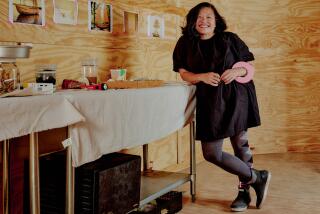‘Angel of Saigon,’ Viet Orphans Took Each Other to Heart
- Share via
SEATTLE — The children of Vietnam’s An Lac orphanage are men and women now, scars slowly fading more than two decades after their war ended.
Rescued as babies from an uncertain fate in war-torn Saigon, adopted by American families and schooled in U.S. colleges and universities, they have gone on to share in the American dream. Many have families of their own now.
But they do not forget the petite, dark-haired American woman who gave them a second chance. Nor has she forgotten them.
She is Betty Tisdale, but the children of An Lac knew her as Miss Bet-ty or Miss Sweet. Some called her the Angel of Saigon.
Tisdale raised money for and helped run the orphanage. She scrubbed floors, changed diapers and taught English to hundreds of abandoned or orphaned babies.
When the North Vietnamese army closed in on Saigon in 1975, she organized an airlift of more than 200 An Lac orphans to the United States, where all were adopted by American families. Tisdale and her then-husband, Army doctor Patrick Tisdale, adopted five of the children themselves.
“It became my life. I just felt I was meant to do this,” Tisdale said in a recent interview at her home in Seattle’s Queen Anne neighborhood, where she has lived since 1982.
“The Vietnamese people that came here are still part of my life. The ones that I left behind are still part of my life. And my children. I can’t imagine what life would be without them.”
*
The mission that would take Tisdale half a world away began in the late 1950s, when she read a book about Dr. Tom Dooley, a U.S. Navy lieutenant who devoted much of his life to helping the sick and poor of Southeast Asia.
Dooley helped found the An Lac orphanage in Saigon in the mid-1950s with Madame Vu Thi Ngai, a wealthy, college-educated widow who fled to South Vietnam after the Communist takeover in North Vietnam.
Ngai assumed a caretaker role as she made her way south, taking under her wing homeless children she encountered along the way. Over the ensuing years, she cared for thousands of youngsters at An Lac, which means “happy place.”
In New York City, Tisdale--then Betty Moul--started working for Dooley as a volunteer, helping with typing and other office duties. After Dooley’s death in 1961, Tisdale, then in her late 20s, took over fund-raising for the orphanage and made her first trip to Southeast Asia.
Her up-close look at An Lac changed her life.
In a dilapidated former French military barracks at No. 116 Nguyen dinh Chieu St. in Saigon, toddlers sat on overturned pots. Stools and urns of water served as makeshift showers. Food was cooked in pots placed on charcoal burners on the dirt floors.
“I walked in and saw the rusty cribs with hammocks and rags hung between them, the tiny, emaciated babies lying there with rags,” Tisdale recalls.
“I knew that I couldn’t go back to New York and be the business girl, the swinging single, everything that New York portrayed. I knew that I had to change my life.”
After a second trip to An Lac in 1963, Tisdale returned to New York and landed a job as private secretary in the New York City office of the late U.S. Sen. Jacob Javits (R-N.Y.) where she worked for the next six years. She began courting donations from society’s movers and shakers.
Soon she was sending as much as $5,000 a month to the orphanage, as well as corporate gifts--tons of diapers from Johnson & Johnson, cartons of mislabeled baby food from Heinz.
There were some cross-cultural complications.
“Someone said Tang had a lot of vitamin C. I wrote to Tang and got stacks and stacks of it. When I got to the orphanage, there it was, all stacked in a room. I said, ‘Madame Ngai, why aren’t you using this?’ She said, ‘They [the children] don’t like it.’
“I said, ‘Let me try.’ She didn’t know it had to be diluted in water. The minute we did that, they were drinking it like mad.”
*
Tisdale spent her vacations--a few weeks around the Christmas and New Year’s holidays--visiting An Lac. She saved money for the trips by skimping on lunch--”Howard Johnson’s had the best hot dogs for 30 cents”--and buying her clothes at discount stores. She stayed in Javits’ office after hours to use the office typewriter.
By the early 1970s, the orphanage had added washing machines and dryers, a new kitchen, indoor showers, a station wagon and bicycles that made it easier for the children to attend school.
In the spring of 1975, when bombings were routine and the fall of Saigon was imminent, Tisdale returned to An Lac one last time with actress Ina Balin, intent on rescuing all of the approximately 400 orphans then at An Lac.
They persuaded Vietnamese government officials to allow an airlift of all the children to the United States. But at the last moment, trying to avert pandemonium, the government decreed that only children under 10 could leave.
Working for three days straight with little sleep, Tisdale and Balin rejiggered the list and drafted identification papers to comply with the ultimatum--a task complicated by the fact that none of the children had birth certificates. Some of their documents showed various older children to be 8 or 9, though one reportedly began shaving the next year.
As the children were loaded onto Air Force planes--the babies were placed in boxes strapped to the floor--Tisdale stepped inside the An Lac nursery one final time.
“I went to get the last baby and I looked and you couldn’t hear a sound, which is not like An Lac. There wasn’t a baby crying. There wasn’t a gurgle. There wasn’t anything but silence,” Tisdale recalls.
“And it was then that I thought to myself, ‘Am I playing God? What am I doing taking all these children?’ ”
In all, 219 children were flown out of An Lac on April 12, 1975. One 3-month-old boy died en route.
On April 29, 1975--the day before South Vietnam fell to the Communists--Tisdale flew to Guam and arranged for Madame Ngai and her two assistants to come to the United States. Ngai lived with the Tisdales in Columbus, Ga., until her death three years later at age 74.
*
The An Lac airlift was the largest from a single orphanage. All the children found permanent adoptive homes through Tressler Lutheran Services of Pennsylvania. The story was made into a 1980 television movie, “The Children of An Lac,” starring Shirley Jones.
More than 150 older An Lac orphans were left behind, many of them carted off to work camps in the jungles when the Communists took over.
In April 1995, 20 years after Saigon’s fall, Tisdale and adopted daughter Kim returned to Vietnam and visited the old An Lac building, which had been converted into low-income housing.
When word got around that Miss Bet-ty was in town, several of the An Lac orphans who had been left behind--most now in their 30s--began showing up in the lobby of her hotel.
Tisdale rented a bus, rounded up a few dozen of them and drove to one boy’s rural farmhouse for a hearty reunion.
These days, she says, she spends most of her time acting as an information resource and go-between for others involved in philanthropic work. She is active in the Tibetan human-rights campaign. She also sits on the board of the Variety Club, a children’s charity, and the World Affairs Council, an educational organization.
But the children of An Lac remain at the heart of her life.
The young woman now called Adele Emrich was 22 months old and weighed just 14 pounds when she was flown out of An Lac. A victim of severe malnutrition, she was not expected to survive the flight. But she did, and was adopted by a family in Millersville, Pa.
She will graduate this summer from Millersville University with a degree in biology, and is considering applying to medical school to become a pediatrician.
Had it not been for Tisdale, Emrich says, “I’m almost certain I would not be alive today.
“It’s nothing short of a miracle what she did.”
A magazine article at the time labeled Tisdale, “The Angel of Saigon.”
One reader wanted to thank Tisdale for her work and wrote a letter addressed simply to: “God’s Angel, Senator’s Office, Park Avenue.” Tisdale received it.
“I think there is a tendency to make a person like Betty larger than life, and I think she’d be first to say she’s really just a human being doing a job that she felt needed to be done,” said Bill Tremitiere, vice president for constituent relations at Tressler Lutheran Services.
“She accomplished what a lot of people wouldn’t even think of trying.”
Tisdale is pragmatic about the “Angel” label.
“It was one of several articles and it helped raise money, and if anything would help the children, then I was all for it.
“It helped bring the plight of the children to the rest of the world, and if I could do that, then fine, I’d like to be the Angel of Saigon.”
More to Read
Sign up for Essential California
The most important California stories and recommendations in your inbox every morning.
You may occasionally receive promotional content from the Los Angeles Times.










